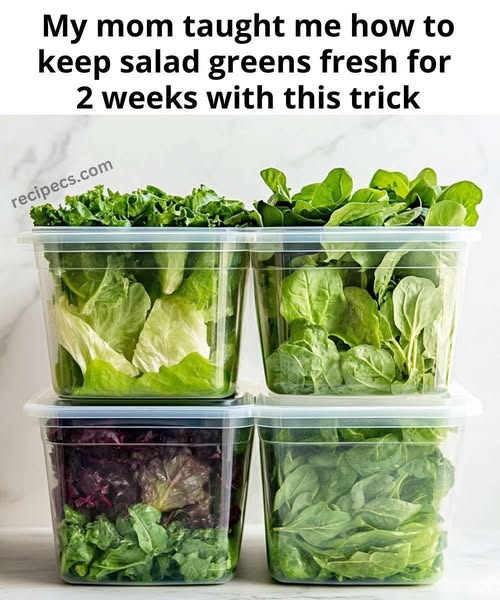Extend the Shelf Life of Salad Greens with This Simple Trick!
May 27, 2025 by admin
There’s nothing more disappointing than discovering your once-crisp salad greens have turned into a soggy mess at the bottom of the fridge. But keeping salad greens fresh doesn’t require special equipment or costly gadgets. With one simple, science-backed trick, you can extend the shelf life of your greens for up to two weeks—sometimes even longer.
Whether you’re a home cook, meal prepper, or just trying to eat healthier, this method will help you reduce food waste, save money, and always have fresh greens on hand.
Why Salad Greens Spoil So Quickly
Salad greens like spinach, arugula, romaine, and mixed spring blends are naturally high in moisture content. This makes them particularly vulnerable to:
- Wilting
- Sliminess
- Rot and bacterial growth
Once harvested and packaged, greens begin to deteriorate almost immediately. Poor airflow, trapped humidity, and temperature fluctuations accelerate spoilage. The average bag of greens lasts 3–5 days once opened, but that timeline can be drastically improved.
The Best Way to Store Salad Greens – The Paper Towel Trick
Here’s the most effective and easiest way to keep your salad greens fresh for longer—no vacuum sealers or expensive containers necessary.
What You’ll Need:
- A container or sealable plastic bag
- Clean, dry paper towels
- Washed and dried salad greens
Step-by-Step Instructions:
- Wash and Dry the Greens Thoroughly Rinse the greens under cold water to remove dirt, pesticides, or debris. Then, dry them completely using a salad spinner or clean kitchen towel. Moisture is the enemy of freshness, so drying them properly is essential.
- Layer with Paper Towels Place a dry paper towel at the bottom of a container or zip-lock bag. Add a layer of greens, then place another paper towel on top. Repeat this layering process if you have a large quantity.
- Seal and Store in the Refrigerator Close the container or bag tightly, squeezing out as much air as possible without crushing the greens. Store in the vegetable crisper drawer of your fridge.
- Change Towels Every Few Days Replace the paper towels every 2–3 days if they become damp. This prevents excess moisture buildup, which is the primary cause of spoilage.
This technique extends freshness by balancing humidity control and airflow, allowing your greens to breathe while preventing sogginess.
Use Glass Containers for Even Better Results
While plastic bags work well, glass containers provide a more stable environment. They protect delicate leaves from getting crushed and prevent odors from seeping in. Use containers with lids that allow for slight airflow, or prop the lid open just a bit.
Best Greens for Long-Term Storage
Not all greens are created equal. Some hold up better than others when stored using the paper towel method:
- Romaine lettuce – Crunchy and durable, great for extended storage.
- Kale – Hardy and fibrous, resists wilting.
- Spinach – More delicate but stores well when dried thoroughly.
- Arugula – Peppery and soft; should be eaten sooner but can last longer with this method.
- Butter lettuce – Tender leaves, handle with care but responds well to proper storage.
Avoid These Common Storage Mistakes
Even with the best technique, several mistakes can cause greens to spoil prematurely. Be sure to avoid:
1. Storing Wet Greens
Water left on leaves encourages rot. Always dry greens thoroughly before storage.
2. Overstuffing the Container
Cramming too many greens into a bag or container restricts airflow. Give them space to breathe.
3. Keeping Greens in Original Packaging
Store-bought packaging traps condensation. Transfer greens to your own container with paper towels immediately after opening.
4. Not Monitoring Fridge Temperature
Greens store best between 32°F and 40°F (0°C–4°C). Too warm and they’ll rot; too cold and they’ll freeze.:
Bonus Tip: Refresh Wilted Greens
If your greens look a little limp but haven’t gone bad, there’s still hope. Rehydrate them by soaking in ice water for 5–10 minutes. Dry them thoroughly afterward, and they’ll regain much of their original crispness.
Meal Prep Ideas to Use Up Your Greens
Now that your greens last longer, use them wisely. Here are some quick and healthy ways to make the most of every leaf:
- Green Smoothies: Blend spinach, kale, or arugula with fruit, yogurt, and nut milk.
- Salad Jars: Layer ingredients in mason jars for grab-and-go lunches.
- Sautéed Greens: Quickly cook spinach or kale with garlic and olive oil.
- Egg Scrambles: Toss chopped greens into your morning eggs.
- Wrap Fillings: Use romaine or butter lettuce as wraps for tuna, chicken, or tofu.
Eco-Friendly Alternative: Use Cloth Towels
If you’re looking to reduce waste, swap paper towels for reusable cloth towels or microfiber kitchen cloths. They function the same way and are washable. Just be sure they’re fully clean and dry before reuse.
How Long Can You Actually Keep Salad Greens Fresh?
With the paper towel method:
- Romaine: Up to 14 days
- Spinach: 10–12 days
- Kale: Up to 2 weeks
- Spring Mix: 7–10 days
- Arugula: 5–7 days
Always inspect for slimy leaves, odd smells, or discoloration, and discard any questionable parts to protect the rest.
Reduce Food Waste and Save Money
On average, households throw away over $150 worth of produce annually due to spoilage. By implementing this simple trick, you’ll not only keep your greens fresh—you’ll cut down on waste, reduce trips to the store, and stretch your grocery budget.
Conclusion: Keep Greens Fresh with a Simple Paper Towel Hack
This method is not just practical—it’s proven. Whether you’re prepping for the week or just want your salads to taste as fresh as possible, following this simple paper towel trick can revolutionize the way you store salad greens. No fancy storage gadgets, no preservatives, just smart, strategic storage.
